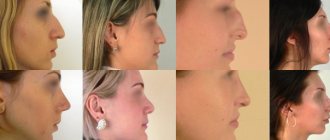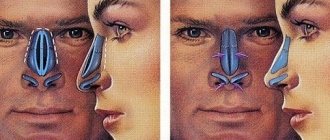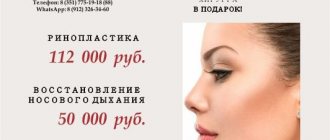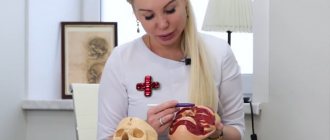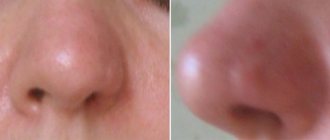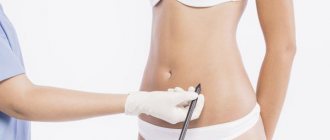Surgery to correct the nasal septum (septoplasty) is a subtype of rhinoplasty that is designed to correct a deformed nasal septum. It can become deformed (curved) as a result of a previous injury, an unsuccessful operation, as a consequence of an illness, or it can be this way since the patient’s birth.
A deviated nasal septum is not only a cosmetic defect, but also an obstacle to free nasal breathing, as well as the cause of chronic inflammatory processes. But septoplasty can correct this problem once and for all.
There are these types of operations:
- Endoscopic septoplasty. In this operation, bone, cartilage tissue and mucous membrane are excised directly inside the patient’s nasal cavity, without the use of additional incisions. The undoubted advantage of such an operation is the absence of a long recovery period. All manipulations are carried out using an endoscope, which gives this type of nasal septum surgery its name. The operation is quick and usually lasts no more than an hour. The rehabilitation period is usually short.
- Laser correction. This type of septoplasty is considered the most painless and safe. The rehabilitation period after the laser method is very short, and the risk of hematomas, perforations and suppurations is minimized. The procedure takes about 30 minutes. A significant disadvantage of this type of septoplasty is that the laser beam cannot correct serious problems and deformations.
Prices for contour rhinoplasty
The cost of the operation is indicated in full (including local anesthesia).
| Medical service | Price |
| Consultation with a plastic surgeon | 2 000 |
| Rhinoplasty | |
| With resection of the distal septum | 186 000 |
| With columella correction | 191 000 |
| With lowering of the nasal bridge | 196 000 |
| Rhinoseptoplasty | 225 000-245 000 |
| Revision rhinoplasty | 230 000-260 000 |
Information for patients from other cities:
Write to the doctor on your personal What'sApp for an online consultation if you are not able to come several times. Phone numbers can be found here. If the doctor does not answer immediately, then most likely he is in the operating room and will answer you as soon as possible.
How is the operation performed?
Septoplasty is considered a rather complex operation, since not only the outer integument is subject to correction, but also bone and cartilage tissue. Septoplasty is usually performed under general anesthesia to minimize the patient's discomfort.
Before carrying out it is necessary to undergo tests for the general condition of the body. Preparation for septoplasty includes the following nuances:
- if correction of a deviated septum is carried out in a woman, then you need to wait 1 week after the end of her last menstruation;
- You should temporarily stop taking medications that affect blood clotting, smoking and drinking alcohol for at least 2 weeks.
The duration of septoplasty can range from 1 to 3 hours. This depends on the complexity of the problem, as well as the presence of individual factors complicating the course of septoplasty. After correcting the deviated nasal septum, special tampons are fixed into the nasal cavity on both sides to stop bleeding. After 24 hours, the tampons are removed and the patient goes home with recommendations. During the week, the patient undergoes a nasal toilet 3-4 times in order to avoid postoperative complications.
There are contraindications, you should consult your doctor.
Rhinoplasty (nose job)
The Swiss writer Lavater wrote about noses: “The nose has incomparable importance for a physiognomist; no other feature can outweigh its decisive role. The nose is both a state of health, and temperament, and all kinds of character traits, and spirituality - the nose is fateful! You may be surprised at the categoricalness of my statement and object: the nose is not everything! After all, any nose, any shape and size can be combined with any number of different looks of other parts of the face and body.
Yes, maybe, but if you have heard an orchestra at least once, then you know what the importance of the conductor is and what the part of the leading instrument is. The middle and most protruding part of the face is the bridge connecting its oculo-frontal top and the oromaxillary bottom, representations of the spiritual and carnal principles - the nose is the conductor of the orchestra of physiognomy.
A conductor who sometimes takes on the role of first violin, solo clavier or even organ... I dare to assure you: not just any nose can be connected to anything in the face and body, as well as in the soul.”
Nose job
Rhinoplasty is an operation to change the shape of the nose, Septoplasty is an operation on the nasal septum.
Rhinoseptoplasty is a combination of two operations in complex cases, which are performed simultaneously.
The simplest operation to change the shape of the nose and the most complex, exclusive one are formally called the same - RHINOSEPTOPlasty. At the same time, the final results differ significantly in their final form.
Surgeries to change the shape of the nose can be reconstructive, aesthetic, or mixed.
During reconstruction, the doctor attempts to return the nose to its previous shape and functionality. Through incisions inside the nostrils, peeling off and lifting the skin, the surgeon carefully isolates and fixes the osteochondral fragments of the nose in the corrected position. However, if these anatomical structures are significantly changed or damaged, it is extremely difficult for the surgeon to create the previous shape of the nose, even if he makes external incisions and has a clear view of the surgical field.
Aesthetic surgery is performed to create a more beautiful nose shape. In this case, the doctor’s possibilities are great, but not unlimited. The degree to which the desired result is achieved depends on the structure and condition of bones, cartilage, skin thickness and elasticity, face type and age of the patient. Often thick skin visually smoothes and simplifies the most elegant cartilaginous structure that was supposed to define the neat tip of the nose. The most complex and interesting are mixed operations, when it is possible to create a new desired shape from the “fragments” of an injured nose.
Complications
Any operation is associated with a certain amount of risk, but the medical risk against which you can insure is minimal.
The maximum risk that cannot be insured against is aesthetic.
What if you don’t like the operated nose? In fact, you are experimenting with your appearance on your own initiative through the efforts of the surgeon. Don't count on it, but hope that the doctor will do more for you than he can.
Console yourself with the fact that there are corrections, that is, short-term interventions that eliminate minor deficiencies, and that the doctor does them at his own expense.
Postoperative period
If you were sufficiently motivated before the operation, you will have no difficulty in holding out
2-3 days without nasal breathing, 7 days in a cast, 2-3 weeks with bruises and swelling on the face.
The swelling on the nose lasts for about a year. Due to swelling, the shape of the nose resembles its previous one.
But every cloud has a silver lining: thanks to this “disguise”, those around you will gradually get used to your new image. Swelling decreases, and within a year the future shape of the nose and face as a whole is revealed.
You can view the results of rhinoseptoplasty work here:
Protocol for non-surgical rhinoplasty using Bio S Line mesothreads.
Introduction
Thread rhinoplasty can correct many aesthetic defects.
Compared to surgical manipulations, its advantages are that it is low-traumatic, does not require long rehabilitation and does not lead to the psychological discomfort experienced by patients who are forced to walk with a bandage on their face. Also, the thread lifting procedure has few contraindications and, if performed by an experienced cosmetologist, gives a minimal percentage of side effects.
Non-surgical nose correction using threads helps to narrow a wide base, form a clearer contour, correct the shape of the wings of the nose, and correct a long or drooping tip.
Clinical case
Patient, 35 years old. Complaints about an inharmoniously large nose relative to the geometry of the face. Bio S Line mesothreads made of polydioxanone (first porosity class) were chosen for correction:
- threads with bidirectional notches arranged in a spiral, “Christmas tree” in an atraumatic cannula Cog 2 (75 mm) - 2 pcs.,
- Dual Arm Needle threads (29 cm), C-shaped, with bidirectional notches, located on two atraumatic needles - 1 pc.
Procedure protocol
The procedure was carried out in two stages.
First stage. Formation of the upper line of the nose. Installation of herringbone threads in the Cog 2 cannula.
- We carry out primary processing and marking.
- We anesthetize only the tip of the nose. Here we use a trocar to create a shallow puncture for installing threads.
- We insert two cannulas one at a time and pass them along the back of the nose, controlling the installation layer (strictly subdermal).
- We flood the anchor part of the threads, and then remove the cannula. Pull the thread by the free end. We cut off the ends of the threads and embed them in the fabric.
Second phase. Formation of a clear contour of the nose, correction of the tip. Installation of Dual Arm Needle threads.
- We anesthetize only the injection and puncture points (the lateral surface of the tip of the nose). When choosing an injection point, it is important to remember about anatomically dangerous zones.
- Install the threads from top to bottom. Alternately, from one channel, we pass atraumatic needles along the lateral surfaces of the nose, thus visually emphasizing a clear contour.
We place the needles strictly in the subdermal layer, controlling the layer with pendulum-like movements.
- We make punctures along the side surface of the tip of the nose, pull out the thread completely, sinking the knot into the dermis.
- We tighten the threads by placing soft tissue on the thread. This way we form clearer lines of the nose. There is a visual shortening of the nose, the boundaries of the nose are drawn.
- Cut off the loose ends and embed them in the fabric.
Correction result
As a result of the procedure, it was possible to form clearer side edges, raise the tip, make the nose more neat, and the face more harmonious.
Conclusion
Adramatic Bio S Line needles and cannulas, the absence of excessive separation by the trocar, as well as minimal anesthesia reduce the risk of edema and hematomas as a result of the procedure. There are practically no traces of implantation. The effect lasts up to one and a half years.
The procedure for nose correction using Bio S Line mesothreads allows you to achieve a noticeable aesthetic correction of the nose without affecting the patient’s social lifestyle.
Author: Milena Papikyan, dermatovenerologist, cosmetologist, Moscow.
Magazine: Appearance. Esthetic guide №5(33)
Theorinoplasty
Rhinoplasty has always been considered one of the most popular operations in plastic surgery. Traumatic surgery can cause complications and require long-term rehabilitation. In our clinic you can use the services of changing the size and shape of the nose using a new innovative method - theorinoplasty. Minimally invasive surgery reduces risks to a minimum percentage, and recovery will require a record short time.
Benefits of theorinoplasty
Theorinoplasty is named after its creator Teoman Dogan, a candidate of medical sciences, plastic surgeon and anatomist. The method allows you to minimize trauma and securely fix the tip of the nose. As a result of the operation, such a complication as a drooping nasal tip was excluded.
The advantages of theorinoplasty include:
- The surgery is performed through small incisions inside the nose.
- Theorinoplasty is performed without removing the costal cartilage.
- After the procedure, long hospitalization is not required.
- The use of modern splints and minimally invasive surgery allows a person to breathe freely immediately upon awakening after surgery.
- 100% protection against nasal tip drooping, unlike other methods.
How is the rehabilitation going?
Theorinoplasty of the nose allows patients to go home from the clinic the next day. You can begin work duties in 3–5 days, and after a week you can fly on an airplane. You are allowed to return to your normal daily routine after a month. You will be able to engage in active sports, visit swimming pools, baths, saunas, etc.
The final result of theorinoplasty will be visible after 2 months. During this period, tissue stabilization will completely occur. The main advantage is the absence of a “snub nose” - an upturned tip. The method is also suitable for patients who have previously undergone rhinoplasty. This minimally invasive surgery can be performed on people of any age. Restrictions are only due to health reasons.
Features of theorinoplasty
The original shape and size of the nose does not matter - theorinoplasty helps in any case. Our patients can be confident in a stable result. The success of the operation is ensured by the use of theostratum: the cartilaginous formations of the nasal septum are carved out in the form of a small strip, which is attached to the end part of the septum. Not theostrate, all soft tissues are located together with cartilage, ligaments and epidermis. Despite the pressure of gravity, the theostrat excludes the possibility of the tip falling completely. As a result, our patients receive an aesthetic appearance without negative consequences.
Theorinoplasty is indicated not only for beauty - it is a rational solution to the problem of constant nasal congestion. Correcting the septum and shape at the same time will help you get rid of unpleasant symptoms and give your appearance a harmonious aesthetic.
